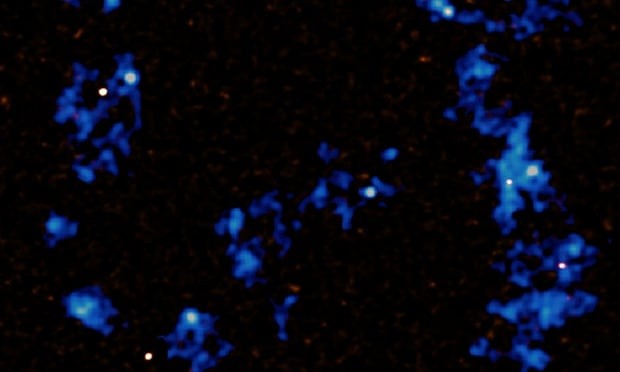
Humanity has just made one giant leap in the quest to understand how galaxies first formed in the early universe. The Cosmic Web has just been observed for the first time. Theorized for years but never been confirmed recently, the Cosmic Web is the term generally agreed on by astronomers as the overall structure of the universe. It is a giant network of filaments that connect galaxies, and it has been thought to stretch out throughout the entire universe.
Images taken by the European Southern Observatory's Very Large Telescope show that in the Aquarius constellation about 12 billion lightyears away there are visible gas filaments that link a cluster of galaxies known as the SSA22 Proto cluster. To give you an idea of the scale of this, a protocluster is a group of hundreds to thousands of galaxies. It is the beginnings of a galaxy cluster or the largest known collection of cosmic bodies that belong in one giant gravitational field.
Major studies in theoretical physics and cosmological simulations have previously suggested that in the aftermath of the Big Bang, some 13.8 billion years ago, 60% of the universe's hydrogen had broken down into massive sheets. This is known as the cold dark matter theory of galaxy formation. After a while, those sheets then broke down into gas filaments that stretched out into the vastness of space. The intersections of these filaments are now thought to be the starting points of galaxies, and that these filaments continuously feed gas into them-a network that serves as the structure to facilitate the formations and growth of galaxies.
"They are thought to fuel the intense activity seen in galaxies--star formation and the growth of supermassive black holes," says Hideki Umehata, the lead author on this study. Umehata is an astronomer for the RIKEN Cluster for Pioneering Research in Japan.
He goes on to say that the reason the gas filaments that make up the Cosmic Web have been difficult to observe and document is their faintness. Even with specialized equipment, the gas filaments have been mostly invisible, until now. However, the galaxies within this protocluster with young stars essentially acted as a sort of lamp for these gas filaments, illuminating the Cosmic Web.
"It is very exciting to clearly see for the first time multiple and extended filaments in the early universe. We finally have a way to map these structures directly and to understand in detail their role in regulating the formation of supermassive black holes," says Professor Michele Fumagalli, co-author of the study.
The existence of the Cosmic Web is considered by many to be confirmation that the Standard Cosmological Model is correct and that there is a large-scale structure in the universe. A deeper study of the Cosmic Web will also allow astrophysicists to predict and map regions of the universe previously thought as unknowable.
Further studies and many more intensive observations of the Cosmic Web is likely to teach humanity about the beginnings of galaxies, galaxy clusters, and ultimately the universe itself.











